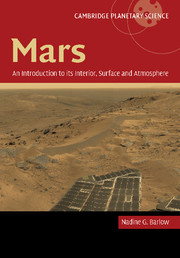Book contents
- Frontmatter
- Contents
- Preface
- 1 Introduction to Mars
- 2 Formation of Mars and early planetary evolution
- 3 Geophysical measurements and inferred interior structure
- 4 Surface characteristics
- 5 Geology
- 6 Atmospheric conditions and evolution
- 7 History of water on Mars
- 8 Search for life
- 9 Looking ahead
- References
- Appendix: Mission reports
- Index
- Plate section
5 - Geology
Published online by Cambridge University Press: 15 December 2009
- Frontmatter
- Contents
- Preface
- 1 Introduction to Mars
- 2 Formation of Mars and early planetary evolution
- 3 Geophysical measurements and inferred interior structure
- 4 Surface characteristics
- 5 Geology
- 6 Atmospheric conditions and evolution
- 7 History of water on Mars
- 8 Search for life
- 9 Looking ahead
- References
- Appendix: Mission reports
- Index
- Plate section
Summary
Solid bodies have their surfaces affected by geologic processes. By studying the current state of a planetary surface and applying our terrestrial experience of what features are associated with the different geologic processes, planetary geologists disentangle information about the geologic and thermal evolution of the body in question.
Geologic processes are divided into internal and external processes. Internal processes originate from within the body and include volcanism, tectonics, and mass wasting (caused by the planet's gravity). External processes originate outside of the planet's interior and include impact cratering, eolian (wind-blown), fluvial, and glacial processes. All of these processes have operated on Mars to varying extents.
Geologic terms and techniques
Rocks and minerals
Understanding a planet's geologic history requires development of techniques to read the record left by geologic processes. Solid bodies like Mars are composed of rocks, which are made up of minerals. A mineral is a naturally formed substance with a specific chemical composition. It can be composed entirely of one element or it can be a compound consisting of two or more elements. Minerals usually have a specific crystalline structure and changes in crystal structure, even when chemical composition remains constant, result in a different mineral.
Rocks are composed of a mass of minerals. A rock can be composed of a single mineral type or be a mixture of different minerals. Igneous rocks are rocks that solidify from molten material.
- Type
- Chapter
- Information
- Mars: An Introduction to its Interior, Surface and Atmosphere , pp. 102 - 162Publisher: Cambridge University PressPrint publication year: 2008

